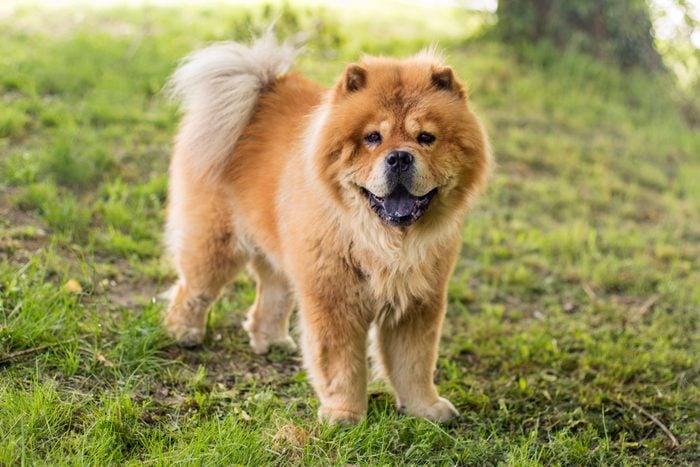
Chinese dog breeds with long histories
Pugs, Shih Tzus and chow chows may seem like modern pet pals, but these Chinese dog breeds have ancient origins dating back centuries—some even a millennium or more. They’re depicted in Chinese art and iconography, and they’re recounted in the stories of Western explorers who made contact with the East. “China may even have been the first place in the world where dogs were domesticated,” says Kelsey Granger, PhD, a historian whose research centers on the tradition of keeping lap dogs in China and how dogs traveled from China along the ancient Silk Road.
So which popular dog breeds originated in China, and how did they become our four-legged best friends? We asked Granger to fill us in on the history of Chinese dog breeds. Then we talked to veterinarian Lisa Neuman, DVM, founder of Bayshore Animal Hospital in North Fort Myers, Florida, about key characteristics of the breeds. Ahead, you’ll learn about the role dogs historically played in Chinese society and what makes these pups in particular so darn lovable.
The history of dogs in China
Millennia ago, dogs were becoming domestic animals in China, though it’s difficult to identify clear breeds, at least according to our modern definitions. Still, Granger says that Chinese “depictions of hunting scenes from around 200 B.C.E. suggest that there were a range of dogs of different sizes and functions.” These include greyhound-like dogs, which would have likely come from Egypt.
The ancestors of today’s furry friends had explicit jobs in ancient China. Granger says dogs were kept for three main uses: as a source of food or sacrifice, as guard dogs or for hunting, which was a sport for the elite. “Hunting dogs like greyhounds or large mastiff-like hounds could be imported as political gifts,” she says, “something that continued throughout Chinese history.”
The tradition of dogs as pets in China started suddenly: The emperor supposedly received a pair of small, exotic “trick dogs” between 618 and 626 A.D. “These two dogs could apparently lead horses by the rein and carry lit torches in their mouths,” Granger says. Once these two pups ingratiated themselves with the royal household, others trotted in as well. Lap dogs—those small and docile enough to be kept on a lap or even in the voluminous sleeve of a robe—became “popular pets among elite women in China across the eighth, ninth and 10th centuries,” says Granger, who notes that they paved the way for keeping other animals, such as cats, as pets.
Interestingly, one of the most revered dogs in Chinese history is not actually a Chinese breed. “The Saluki was a prestigious hunting hound imported from the Persian and Arabian world during the Tang dynasty [618–907 A.D.] and is often featured in tomb murals or tomb ceramics belonging to elite Chinese men,” says Granger. “This dog is a wonderful representation of the exchange of goods and animals along the Silk Roads in this time frame.”
More recently, with China claiming sovereignty over Tibet, many breeds that originated in Tibet have been reclassified as Chinese dog breeds. Whether they’re called Tibetan or Chinese breeds is a matter of history and politics.
With that heady history in mind, let’s take a look at some of the best-known Chinese dog breeds and learn a little about their history and traits.
Get Reader’s Digest’s Read Up newsletter for more pet insights, humor, travel, tech and fun facts all week long.
About the experts
Reviewed for accuracy by: Caroline Coile, PhD, an award-winning journalist specializing in canine breeds, health and science. She’s the author of 34 books, including Barron’s Encyclopedia of Dog Breeds. |
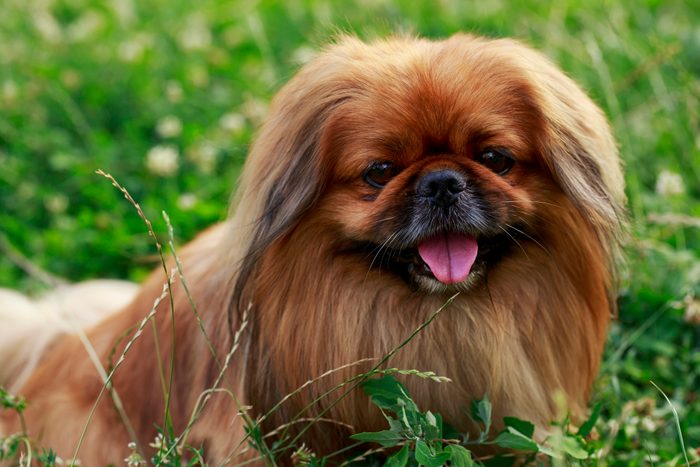
1. Pekingese
The Pekingese is an ancient toy breed that was specifically bred for the ruling classes in China. According to the American Kennel Club (AKC), these dogs are fabled to have been formed by the great Buddha, who shrunk a lion down to a smaller size. That makes sense seeing as Pekingese are famous for their lion-like manes.
Westerners first saw and documented the Pekingese after British soldiers stormed the emperor’s summer palace in Beijing during the Opium Wars in 1860. They were brought to the United States in the late 1890s and were recognized by the AKC in 1906. Pekingese are known for their affectionate nature and loyalty to their humans.
Ready to bring one home? Know that “Pekes” are prone to intervertebral disc disease due to their long stature. “Weight management is key for them, and regular grooming is a must,” says Dr. Neuman, who notes that Pekingese—like all small breeds—can deal with wrist and elbow arthritis in old age. And one other note: They do not tolerate heat well at all.
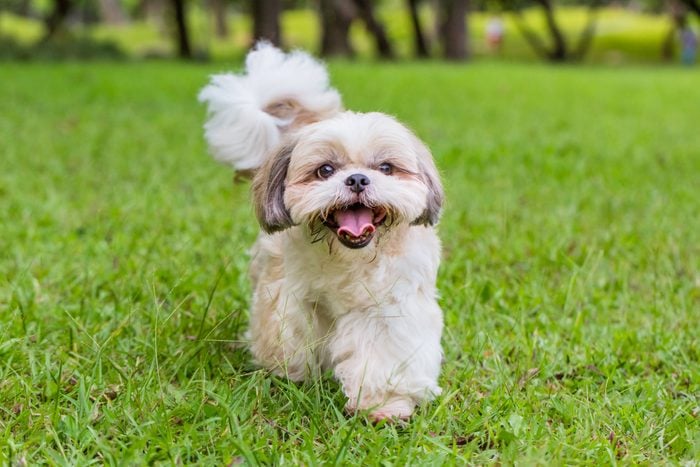
2. Shih Tzu
Shih Tzu is another ancient Chinese dog breed that has a lion-like appearance. They’re known for being playful and affectionate and were also bred behind closed palace doors for the upper classes. It is said that ancient breeders of this dog were gifted extravagant presents by the ruling classes if they could breed the most loving and outgoing lap dogs.
Shih Tzus have become extremely popular throughout the world since the 1930s—the breed is the 20th most popular on the AKC’s list of the top 200 dog breeds—in part because it is a relatively hypoallergenic breed. Dr. Neuman says that, like Pekingese, Shih Tzus have awesome temperaments, though she points out that both breeds can be affected by brachycephalic syndrome, which can cause obstructed airways. Still, Shih Tzus have some of the longest lifespans of any canine, living up to 18 years, which is unusual for dogs. So when you bring one home, there’s a good chance your furry pal will be with you for years to come.
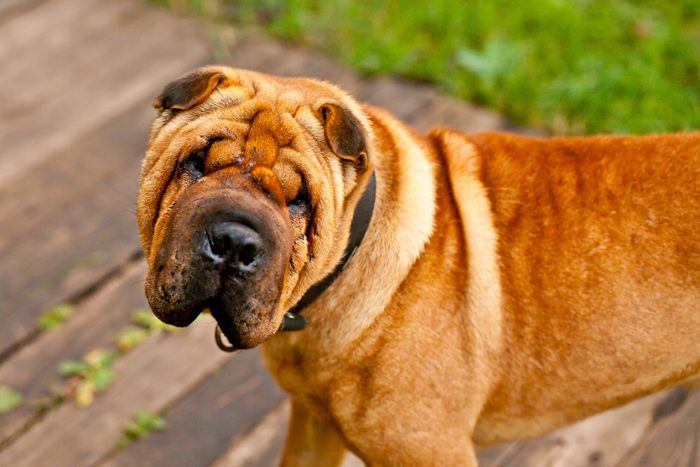
3. Chinese shar-pei
Got wrinkles? If you’re a shar-pei, the answer is a resounding yes. This calm and independent Chinese dog breed can be traced back to the southern provinces circa the Han Dynasty, which existed over 2,000 years ago. Shar-pei were bred specifically for peasants and farmers and served as protective watchdogs over livestock and homes. They are one of the quietest dog breeds and don’t bark too much.
Interestingly, owning dogs was banned by the Chinese Communist Party in 1949, and dogs were systematically targeted for slaughter. This nearly led to the extinction of shar-pei and other Chinese breeds, but fortunately, things have changed. The AKC recognized this pooch in 1992, and today, it’s ranked within the top 100 most popular breeds.
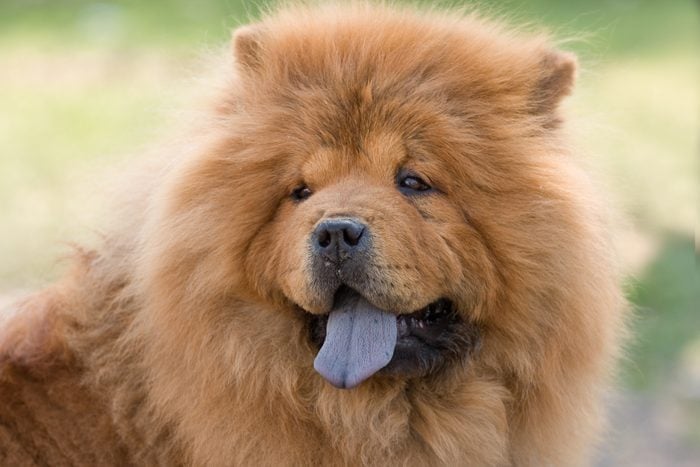
4. Chow chow
The chow chow might just be the oldest dog breed in the world. Artifacts from the Han Dynasty, which dates back to 206 B.C., seemingly depict this magnificent Chinese dog breed. These fluffy dogs were originally bred for palaces—according to the AKC, an eighth-century emperor of the Tang Dynasty owned about 5,000 of them!—but historians believe they were owned and bred by both nobles and peasants alike. They evolved into excellent hunting, hauling and herding pups. Chow chows were discovered by Westerners in the 1820s and displayed as Chinese wild dogs in the London Zoo. Less than a century later, the AKC formally recognized the breed in 1903.
“Chows are great dogs,” says Dr. Neuman, adding that they tend to be one-person dogs. “They have their person,” she says. “They will tolerate their person’s family, but they are suspicious of anyone outside the circle of trust.”
When it comes to caring for your pooch, know this: While a chow chow’s thick undercoat deters external parasites like fleas, it requires a lot of grooming. And be mindful of how all that fur will make your dog feel come summertime. “Obviously, strenuous exercise is discouraged in all breeds during hot summer months,” says Dr. Neuman. That’s when your chow chow will appreciate air conditioning as much as humans do.
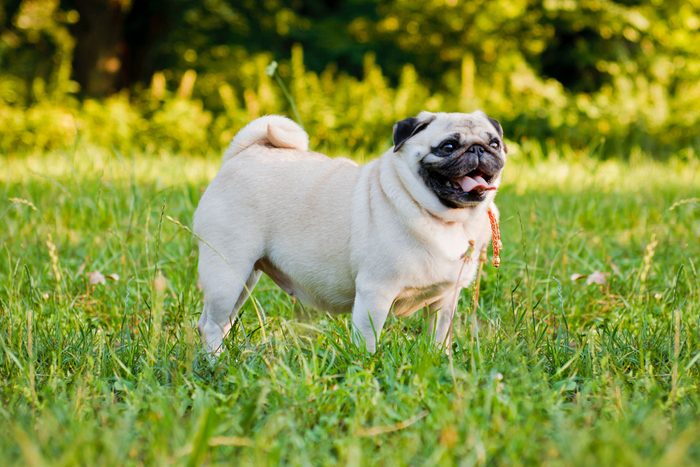
5. Pug
Pugs were fashionable pets in China at least as far back as the Song Dynasty, which ruled from 960 to 1279. Used to living in the lap of luxury—quite literally, as pugs were lap dogs even then—they were introduced to Europe in the 1500s. By the 19th century, Queen Victoria had fallen for these affectionate little pups and reportedly had 36 of them during her long reign. Today, the AKC estimates they’re the 35th most popular breed in America.
As a past pug parent myself, I can attest to the sweetness of the breed—these dogs get along with everyone, are good with kids and other animals, and are generally great pets. But Dr. Neuman cautions that, like other flat-faced breeds, “many pugs are born with anatomical features that contribute to the brachycephalic obstructive airway syndrome.” The condition can be surgically corrected, she says, and the younger you do that, the better. Pugs also tend to be overweight. And light sleepers, take note: They snore. A lot.
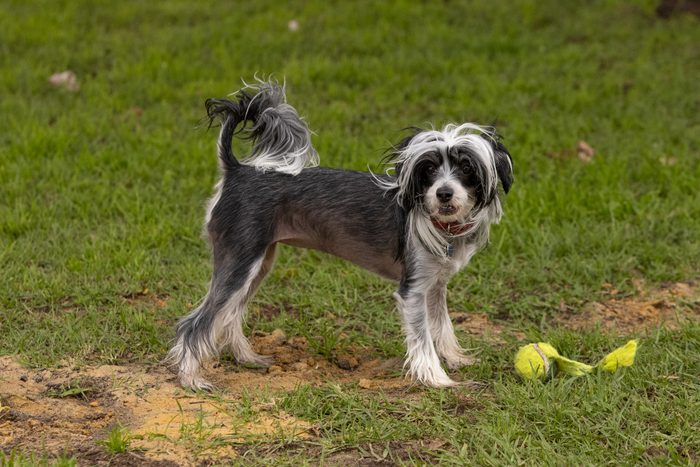
6. Chinese crested
The Chinese crested is a bit of a mystery: With such a long history, its origins aren’t fully understood. Historians believe that ancient hairless dogs arrived in China from Africa and that the Chinese systematically bred these dogs into mini versions. This breed was famously known as the “Chinese ship dog” for centuries, as sailors from all over the world revered the pup for its ability to catch and kill dangerous, disease-carrying vermin living aboard.
It may have taken a while for this ancient breed to earn official recognition in the United States, but the AKC finally recognized this Chinese dog breed in 1991. Today, you’ll come across two types of Chinese cresteds. The hairless variety has fur covering only its ankles, head and tail, while the variety with a coat is covered in soft fur.
These dogs are alert and affectionate with their humans, making for lively pets. “Chinese crested kiddos have a great temperament,” says Dr. Neuman, though she adds that the hairless variety is “prone to blackheads along their [back], and if they live in a sunny climate, they can be prone to sunburn.” As with all hairless breeds, you’ll want to talk to your vet about sun protection for your pup’s skin.
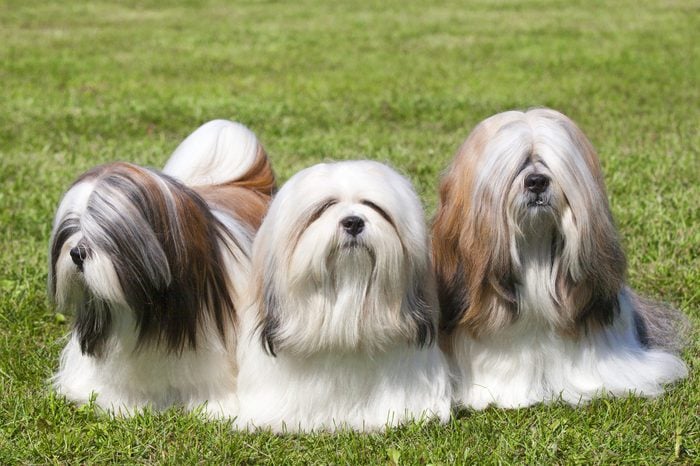
7. Lhasa apso
The Lhasa apso is another ancient breed that dates back a thousand years. Specifically, historians believe these dogs originated in the Himalayan Mountains. Lhasa apsos were primarily used as guards or soldiers that stood watch at the entrance of palaces and Buddhist monasteries. In fact, the Lhasa apso is closely associated with the Dalai Lama; in the 1940s, the Dalai Lama gave these dogs as presents, which helped raise their popularity around the globe.
The word Lhasa comes from the name of Tibet’s sacred city, and apso translates to “long-haired dog,” and those gorgeous coats do require regular bathing and brushing. The fuss is worth it—this breed is a loyal and affectionate companion.
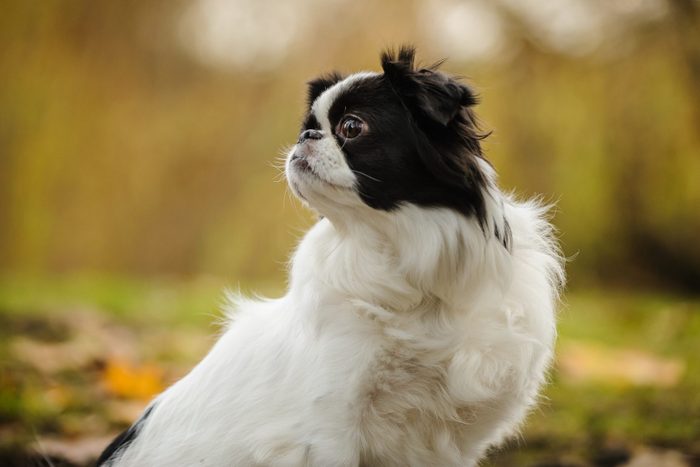
8. Japanese Chin
We know what you’re thinking: The name of this dog has “Japanese” in the title, so how can it be a Chinese dog breed? Well, things get a bit hairy (pun intended) with its origins. Some historians believe that this breed came from Korea, while others say it’s from China. Some even claim that this breed came to Japan via British merchant ships. What we do know is that Japanese Chin is closely related to the Tibetan spaniel, which is also from China.
Japanese Chins are known for being highly affectionate, and they spend ample time in the laps of their most trusted humans. They were recognized by the AKC in 1888 and are currently ranked as the 105th most popular dog breed in the nation. One thing prospective owners should keep in mind: Like other flat-face breeds, Chins are prone to brachycephalic obstructive airway syndrome.
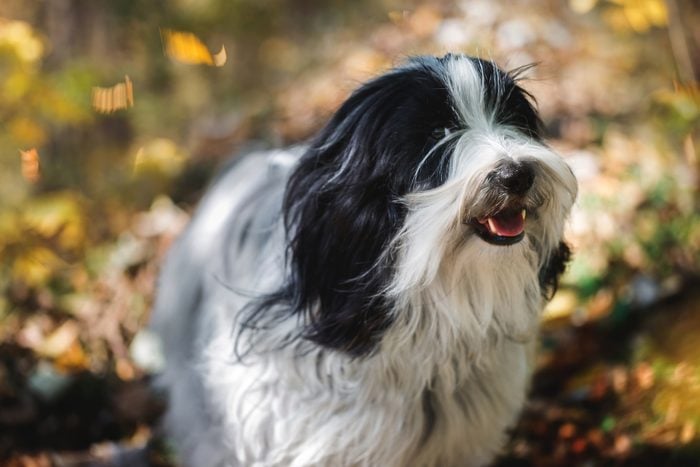
9. Tibetan terrier
The sensitive and affectionate Tibetan terrier is not really a terrier at all. As you can see from their unique appearance, these medium-size dogs hardly share any qualities with the terriers we’re familiar with in the West. They have a unique double coat with a wooly undercoat and ultra-long topcoat, as well as snowshoe-like feet. It makes sense, then, that the Tibetan terrier was bred for the Himalayan Mountains. Like these other dogs with beards, they even have facial hair to keep them warm!
Similar to the Lhasa apso, they have a history of being seen in Buddhist monasteries accompanying the Dalai Lama. Throughout its long history, this breed was also used as a watchdog and herder.
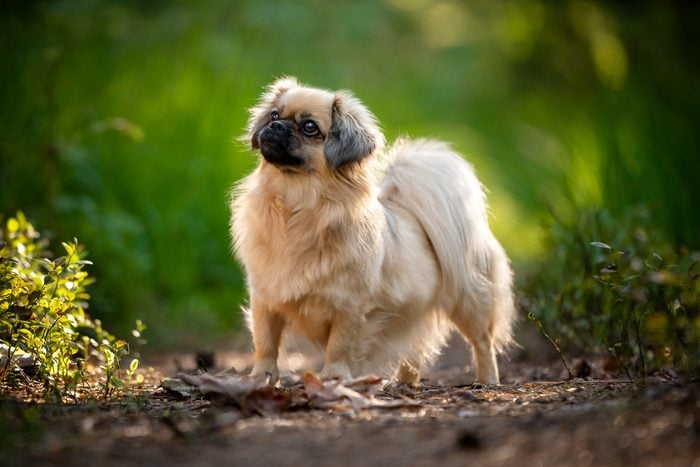
10. Tibetan spaniel
A short dog with a long history, the Tibetan spaniel was originally bred as a companion dog for monks, though it also served as a watchdog. Sitting high on monastery walls, they’d keep an eye out for anyone approaching. These pint-size pups have a lion-like mane, so it shouldn’t be a surprise to learn that Tibetan monks called them “little lions.” Today, these dogs are more likely to be hanging out with their human families than serving as sentinels for monasteries—and that’s quite all right with them. And it’ll definitely be all right with you once you bring one home. Tibetan spaniels are incredibly affectionate and play well with kids.
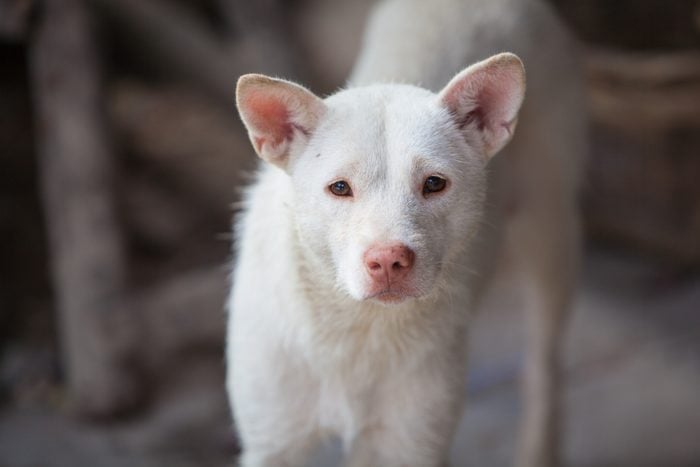
11. Xiasi Quan
The Xiasi Quan is named after the place it originated: the village of Xiasi in China’s Guizhou province. It’s said that in the year 1080, locals developed a sincere respect for the Xiasi Quan and believed that the breed would bring its owners wealth and prosperity. Though the dogs were also bred for hunting, today they are known as kind and gentle pups who prefer to approach life from the inside of their owner’s home. This breed is also quite smart and typically trains easily.
How likely are you to find a Xiasi Quan to make yours? The breed has yet to be recognized by the AKC and isn’t very popular in the United States. In fact, they’re one of the rarest dog breeds in the world, with as few as 300 purebreds in existence.
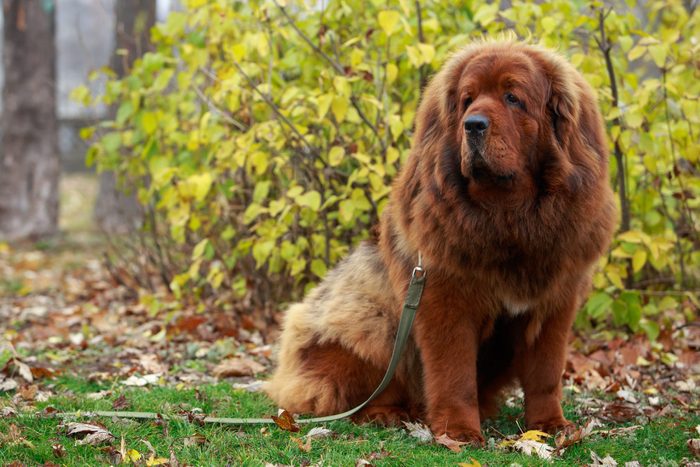
12. Tibetan mastiff
This mighty, intimidating breed originated in the Tibetan Plateau, the highest-altitude plateau in the world. These dogs once protected Buddhist monks from predators and later were used to protect flocks. Tibetan mastiffs are still considered among the best guard dogs. But while they’re loyal to their families, they are not a breed for novice owners—especially since males can weigh up to 150 pounds.
Other things to know about Tibetan mastiffs before you bring one home: They drool a lot, and they shed like crazy. But they don’t require much in the way of grooming, as these dogs are best appreciated in their natural furball state.
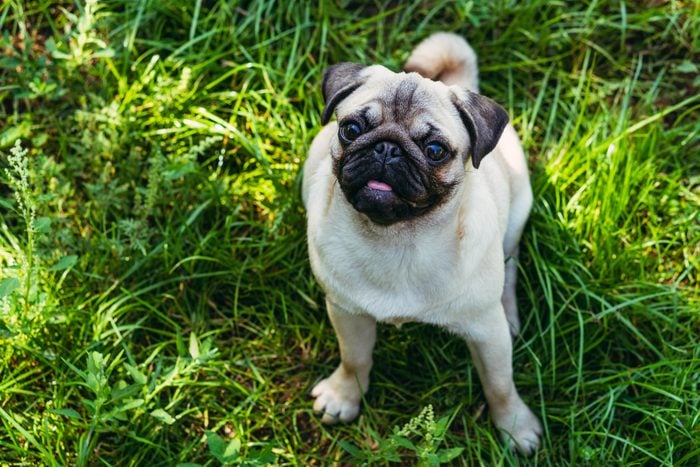
FAQs
What is the history of dogs as pets in China?
While dogs were first domesticated in China as early as 5,000 B.C., they didn’t emerge as pets (in the sense of being companion animals) until the 600s A.D., when a pair of performing dogs were gifted to the royal household. The practice of keeping lap dogs—tiny dogs content to sit on a noblewoman’s lap all day—developed after this point.
What role do dogs play in Chinese culture?
Over the centuries, dogs in China have served as hunting companions, guard dogs and sources of food or sacrifice. A brutal crackdown on pet ownership during the post-WWII Cultural Revolution resulted in the near extinction of some Chinese dog breeds. In the last decades of the 20th century, rules around dog ownership were relaxed, and dogs are once again viewed as faithful, affectionate family companions.
Why trust us
At Reader’s Digest, we’re committed to producing high-quality content by writers with expertise and experience in their field in consultation with relevant, qualified experts. For this piece, Elizabeth Heath tapped her experience covering dog behavior and health, and then Caroline Coile, PhD, an award-winning journalist specializing in canine breeds, health and science, gave it a rigorous review to ensure that all information is accurate and offers the best possible advice to readers. For this piece, we relied on reputable primary sources, including a historian specializing in the history of dogs in China and a veterinarian, as well as our writer’s personal experience. We verified all facts and data and backed them with credible sourcing, and we will revisit them over time to ensure they remain accurate and up to date. Read more about our team, our contributors and our editorial policies.
Sources:
- Kelsey Granger, PhD, historian and Alexander von Humboldt Foundation Research Fellow affiliated with Ludwig Maximilian University of Munich; email interview, Feb. 15 2024
- Lisa Neuman, DVM, veterinarian and founder of Bayshore Animal Hospital in North Fort Myers, Florida; email interview, Feb. 16 2024
- Psychology Today: “What Is China’s Current Attitude Concerning Dogs?”
